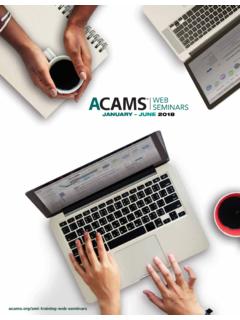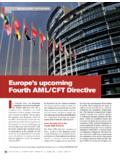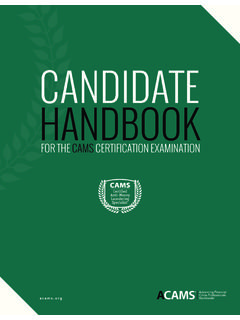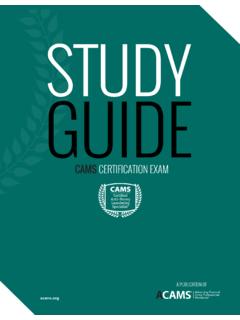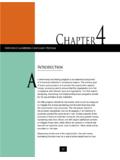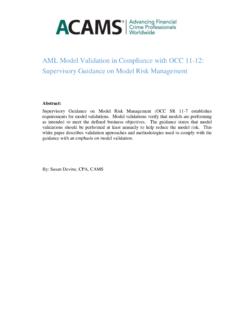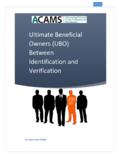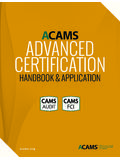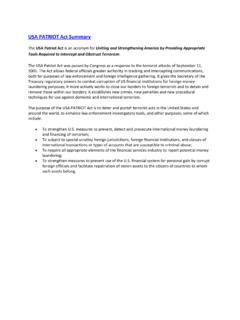Transcription of Cryptocurrency Compliance: An AML Perspective - …
1 Cryptocurrency compliance : An AML Perspective Authored By: Sherri Scott 2 | P a g e Table of Contents Executive summary 3 Blockchain for Blockheads 3 RegTech 5 Sanctions 7 Transaction Monitoring 7 Exponential Growth 7 How to Audit FIs Servicing the Cryptocurrency Industry 8 Conclusion - Unity in the Financial Intelligence Community 10 Exhibit A: The Association of Accounting Technicians (AAT) 11 Reference Document Exhibit : Bitcoin Reference Guide 12 Exhibit C: Money Service Business (MSB) compliance Checklist 13 Exhibit D: Currency Crimes - Federal Money Laundering Laws 15 Exhibit E: Examination Procedures 16 3 | P a g e Executive summary October 31, 2017, marks the 9th anniversary of Bitcoin s introduction to the world, and there is yet a consensus to be made on how to regulate the Cryptocurrency industry.
2 Chances are unlikely that little ghouls and boys will receive bitcoins while Trick-or-Treating this year. It is likely that future gifts will involve e-cards containing Cryptocurrency . The Statue of Liberty is globally recognized as a symbol of freedom. Home of the infamous 9/11 attacks and the heart of the where the Uniting and Strengthening America by Providing Appropriate Tools Required to Intercept and Obstruct Terrorism Act of 2001 was conceived. Better known to anti-money laundering (AML) professionals as the ten-letter abbreviation we hold dear to our hearts, the USA PATRIOT Act An Act of Congress that was signed into law by President George W. Bush on October 26, Today, Lady Liberty also symbolizes the birthplace of Cryptocurrency regulation. The New York State Department of Financial Services (NYDFS) was an early adopter and embraced the financial technology (Fintech) industry.
3 The NYDFS finalized the first regulatory framework in the nation and created BitLicenses, which are now being actively awarded to Virtual Currency Exchanges (VCEs). The Office of the Comptroller of the Currency (OCC) is now challenging the State regulator in a game of Double Dutch as they play jurisdictional jump rope. Which agency will win the argument over legal charter authority? While consistent regulation is lacking, virtual currency exchanges (VCEs) are being denied fair banking services because they are being de-risked by financial institutions (FIs). The discrimination from fair banking services VCEs are facing is comparable to the medical marijuana industry. Unlike its high-risk counterpart, Fintech innovators operate in a field that is federally legal. We will embark on a journey through a brief history of Cryptocurrency , the tides of regulation, and the storms to come.
4 Source: Pinterest 2 Blockchain for Blockheads An anonymous entity known as Satoshi Nakamoto published a white paper3 titled Bitcoin: A Peer-to-Peer Electronic Cash System through a cryptography mailing list on October 31, 2008. The concept is simple: reduce consumer costs by eliminating the banking system from peer-to-peer transactions. The infamous white paper solved the problem of double spending by having an open ledger verified by a consensus of independent individuals. The Association of Accounting Technicians (AAT) put together visual representations that describe both Bitcoin the protocol and the system for spending bitcoins, which can be found on their website4 as well as Exhibit A. Individuals can download free software to create a virtual wallet (VW). The VW is similar to an investment account held at a brokerage firm. Funds are transferred into the account and remain in the form of fiat money (government designated currency) until invested/converted into Cryptocurrency .
5 Each VW has a unique identifier, analogues to an account number or email address. The owner generates a secret key, equivalent to a long alphanumeric pin number, which is unique to each VW and necessary to complete a transaction. 1 Wikipedia Website 2 Image Source << >> 3 Nakamoto, Satoshi, White Paper Bitcoin: A Peer-to-Peer Electronic Cash System (October 2008) 4 The Association of Accounting Technicians (AAT) Reference Document 4 | P a g e Virtual currency exchanges manage virtual wallet accounts and are responsible for obtaining customer information and performing due diligence to the same standard of expectation required by any money services business (MSB). The virtual wallet is initially funded by transferring fiat money from an account held at a financial institution, or transferring Cryptocurrency from another virtual wallet.
6 Although VCEs do not accept cash deposits, customers can deposit cash into a virtual wallet through a Cryptocurrency Automated Teller Machine (ATM). Mining is another method used to obtain Cryptocurrency . Mining is a reward that can be earned when an individual or entity participates in the process of verifying the legitimacy of transactions on the public ledger. Figure 1: How Cash Turns Into Cryptocurrency The transactions are completely transparent with values flowing from one unique identifier to another and are maintained on a public ledger for all to see. Transfers are timestamped and confirmed by a consensus of independent miners. Transactions that occurred during the same interval are grouped together and recorded in chronological blocks of time. Details such as the time, amount, unique identifier of the sender and unique identifier of the receiver are eternally documented.
7 From inception, when first mined, to transfer, and ultimately converted to fiat currency, all movement is noted in the chain of history. This is how the term blockchain was born. According to ,5 927 virtual currencies totaling $100,114,992,312 are in existence today. Bitcoin dominates 41 percent of the $100 billion market. Most alternate virtual currencies created with blockchain technology are based off some derivative of bitcoin. According to Coin ATM Radar,6 there are currently 1,323 virtual currency ATMs operating in 56 countries. Coinbase7 reports that over 46,000 businesses accept virtual currencies, such as PayPal, Dell, Dish, Expedia, , USAA, and Bloomberg, to name a few. A general breakdown of bitcoin denominations can be found in Exhibit B. A global leading tax administrator and the Treasury Department s trillion dollar revenue earning bureau, the Internal Revenue Service (IRS), weighed-in on the issue in March 2014.
8 The IRS classifies virtual currency that has an equivalent value in fiat money (bitcoin being one of them) as a convertible virtual currency (IRS 2014-21)8. For federal tax purposes, convertible virtual currencies are treated as property and are subject to existing tax principles for property transactions. Individuals that mine bitcoins are responsible for legally claiming the fair market value as gross income at that point in time, regardless of when the funds held in a virtual wallet are converted into fiat money. Depending on whether or not the property is a capital asset, the gain or loss in value will be determined at the point in time when the property held in the virtual wallet is converted fiat money. Continued innovation and virtual intelligence is rapidly evolving. Blockchain technology can be used for far more than peer-to-peer transfers of virtual currency. Blockchain technology can be used to securely transfer electronic data and is being considered as a solution for many industries, such as healthcare and addition, an article published by The Economist listed 5 applications for blockchain in your business 10 as follows: 1.
9 Smart contracts 2. Cloud storage 3. Supply-chain communications and proof-of-provenance 4. Paying employees 5 Figures as of 2nd Quarter 2017 Website 6 Coin ATM Radar Figures as of 2nd Quarter 2017 Website 7 Coinbase Website 8 IRS Publication 2014-21 9 A Blockchain For Healthcare. Blockchain for Health Data and Its Potential Use in Health IT and Health Care Related Research 10 Rampton, John. 5 applications for blockchain in your business The Economist Cash deposited into an account held at a Financial Institution (FI)Funds electronically transferred from the Financial Institutionto an account held at the Virtual Currency Exchange (VCE)Funds transferred to the Virtual Currency Exhcange (VCE) are converted into Cryptocurrency and available to use in the Virtual Wallet (VW)5 | P a g e 5. Electronic voting 6 | P a g e RegTech It does not take a boxing enthusiast to appreciate the epic regulatory bout occurring between the New York State Department of Financial Services (NYDFS)11 and the Office of the Comptroller of the Currency (OCC).
10 12 Conflict regarding regulatory jurisdiction of the virtual currency exchanges continues to escalate. Responsible for promoting uniformity and consistency in the supervision of financial institutions, the Federal Financial Institutions Examination Council (FFIEC)13 is an interagency body that houses the combined agency Bank Secrecy Act (BSA)/anti-money laundering (AML) examination In addition to training state and federal examiners, the FFIEC creates federal examination standards for the supervision of FIs. Federal Financial Institution Regulators Board of Governors of the Federal Reserve System (FRB):15 state-chartered/federal reserve member Federal Deposit Insurance Corporation (FDIC):16 state-chartered/non-member federal reserve National Credit Union Administration (NCUA):17 state-chartered credit unions/federal credit unions Office of the Comptroller of the Currency (OCC):5 state-chartered/federal reserve member Consumer Financial Protection Bureau (CFPB):18 FIs and NBFIs operating in the Virtual currency exchanges qualify as money transmitters (MTs), a subcategory of money service businesses (MSBs), under the BSA 31 5312(a)(2)19 and 31 (t), (ff).
